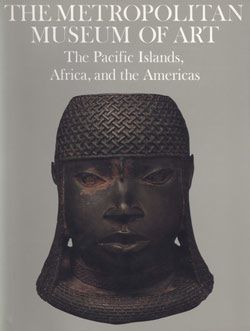Headdress Ornament
Not on view
Created by cutting and embossing sheet metal (in this case a gold-copper-silver alloy), this ornament would have been secured to a cloth turban-like headdress via the pairs of holes at the top and bottom of the central raised image—the face of a snarling feline with prominent fangs. The feline is flanked by two downward-facing birds of prey, and the feline itself wears a crescent-shaped headdress, considered a marker of high, perhaps even divine, status by the Moche people of Peru’s North Coast.
This headdress frontal, one of two nearly identical examples known (the other is in the Museo Larco in Lima, ML100770), is similar to a type of headdress seen on finely painted ceramic vessels made by Moche artisans. For example, on two vessels now in Lima, “ritual runners” are shown wearing headdresses that are surmounted by a disk with a feline face in the center, although those headdresses are encircled by a band of spherical beads (see Donnan 2004:71 and Donnan and McClelland 1999:129). Ritual running by a human or an anthropomorphized animal is one of the most frequently depicted activities in later Moche ceramics. In the absence of texts from this period (writing, as it is traditionally known, was not practiced in South America until the arrival of Europeans in the 16th century), the precise meaning of such imagery is unknown.
Feline-faced headdress ornaments are also found in different shapes, such as the two-pronged frontals found in the tomb of the Lady of Cao, one of the highest-ranked females ever discovered in Peru (Franco Jordán 2011; Mujica Barreda et al. 2007). The present example, however, is particularly striking, not only for the balanced formal elegance of its composition but also for its invocation of sheer power, from the crest of the headdress to the union of terrestrial and aerial predators.
Joanne Pillsbury, Andrall E. Pearson Curator, Arts of the Ancient Americas, 2018
References and Further Reading
Castillo, Luis Jaime. Personajes míticos, escenas y narraciones en la iconografía mochica. Lima: Fondo Editorial, Pontificia Universidad Católica del Perú, 1989.
Castillo, Luis Jaime. “Masters of the Universe: Moche Artists and Their Patrons.” In Golden Kingdoms: Luxury and Legacy in the Ancient Americas, edited by Joanne Pillsbury, Timothy Potts, and Kim Richter, pp. 25-31. Los Angeles: J. Paul Getty Museum, 2017.
Donnan, Christopher B. Moche Portraits from Ancient Peru. Austin: University of Texas Press, 2004.
Donnan, Christopher B. “Moche State Religion: A Unifying Force in Moche Political Organization.” In New Perspectives on Moche Political Organization, edited by Luis Jaime Castillo B. and Jeffrey Quilter, pp. 47–69. Washington, DC: Dumbarton Oaks Research Library and Collection, 2010.
Donnan, Christopher B. and Donna McClelland. Moche Fineline Painting: Its Evolution and Its Artists. Los Angeles: UCLA Fowler Museum of Cultural History, 1999.
Franco Jordán, Régulo. “La Dama de Cao,” Investigación y ciencia 417 (2011):68-74.
Jones, Julie. "Mochica Works of Art in Metal: A Review." In Pre-Columbian Metallurgy of South America, edited by Elizabeth P. Benson. Washington, DC: Dumbarton Oaks Research Library and Collection, 1979.
Jones, Julie, and Heidi King. "Gold of the Americas." The Bulletin of the Metropolitan Museum of Art vol. 59, no. 4 (Spring 2002), p. 19.
Mujica Barreda, Elías, Régulo Franco Jordán, César Gálvez Mora, Jeffrey Quilter, Antonio Murga, Carmen Gamarra, Victor Ríos, Segundo Lozada Alcade, John Verano, and Marco Aveggio. El Brujo: Huaca Cao, centro ceremonial Moche en el Valle de Chicama. Lima: AFP Integra, 2007.
Pillsbury, Joanne, Timothy Potts, and Kim N. Richter, eds. Golden Kingdoms: Luxury Arts in the Ancient Americas. Los Angeles: J. Paul Getty Museum, 2017.
This image cannot be enlarged, viewed at full screen, or downloaded.



